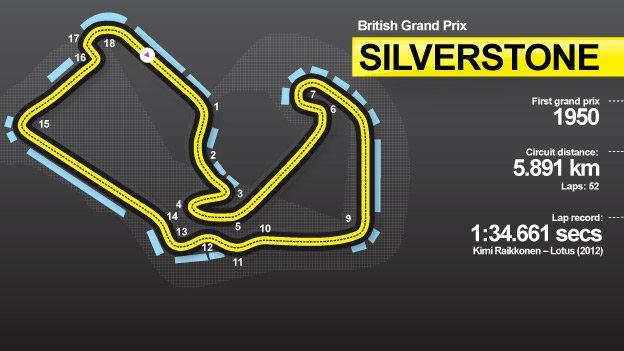British Grand Prix: 'It sends shivers down your spine'
- Published

Silverstone track diagram
Silverstone. The birthplace of modern Formula 1 and one of the most iconic circuits on the calendar.
The first-ever race of the modern F1 era was held at the former World War II airfield back in 1950 and, over the decades, many of the sport's most famous faces have won there.
It has been a while since the home crowd last celebrated a British winner, five years to be exact, when Lewis Hamilton won, external on his way to claiming the world championship., external
Both Hamilton and McLaren's Jenson Button have played down their chances of a home victory this year.
But with local support on their side, coupled with the typically unpredictable British weather, anything could, and probably will, happen...
The track
Silverstone's mix of corners makes it a good test of the abilities of car and driver, but overtaking is difficult.
Becketts and Copse, in particular, are daunting tests for man and machine - and provide spectators with a glimpse of an F1 car's awesome capabilities.
The circuit features 18 corners - 10 right-handers, eight left-handers - and some long straights, making it physically demanding for drivers.
A major change to the circuit in 2010 made for an even greater driver challenge. The new infield layout juts right at the reworked Abbey bend before heading into the new Arena complex of turns, providing three further overtaking opportunities.
Drivers then continue along the main straight of Silverstone's National circuit, before rejoining the previous Grand Prix lay-out at Brooklands.
The venue
Having hosted the first F1 race back in 1950, Silverstone - "the home of British motorsport" - is steeped in the sport's history.
Surrounded by quintessentially English countryside, the Northamptonshire air has been filled with celebratory cheers for wins by Giuseppe Farina, Sir Jackie Stewart, Nigel Mansell, Ayrton Senna, Michael Schumacher and many other F1 greats over the years.
Given its long history, Silverstone had started to look rough around the edges in the early part of this century, seemingly putting its place on the calendar under threat, but a multi-million pound redevelopment in recent years brought it up to date, with the distinctive Silverstone wing having replaced the ageing pit building.
With so many races now in far-flung destinations, for many of the teams in the championship this is considered a "home" circuit, with the likes of Force India, Mercedes, Red Bull, Caterham and Marussia all close by.
What the drivers say
Mercedes driver Lewis Hamilton: "Winning the British Grand Prix in 2008 was an incredible moment for me. I've been aiming to repeat it every year since and I'd love to win my second race at Silverstone. Silverstone is so special for the British drivers and the weekend is made by the amazing support from our home fans. The atmosphere, the flags flying around the circuit and just seeing everyone supporting us really does lift you."
McLaren driver Jenson Button: "Silverstone is a track with such great historical significance - it's where the first-ever world championship Formula 1 race was held, and it's really cool to look at pictures throughout the sport's history and to be able to recognise Silverstone in pictures featuring such icons as Jim Clark, Jackie Stewart, Ayrton Senna and Nigel Mansell. There are very few circuits left that have that sort of history - and we're privileged to have one in Great Britain."
Force India driver Paul Di Resta: "Silverstone is a track that makes you really appreciate what a Formula 1 car is capable of, especially the aerodynamic grip through the quick corners and the change of direction. Everybody talks about Maggotts and Becketts, and there really is nothing else like them anywhere in the world. The atmosphere is electric and I remember last year the drivers' parade was one of the highlights of the year - it really sent a shiver through me."
Marussia driver Max Chilton: "The first British Grand Prix of my F1 career is going to be incredibly special for me, without a doubt. Every race so far in my debut season has been a fantastic learning experience and I'm sure the same will be true of Silverstone, but with additional support from the super-enthusiastic fans of all four British drivers."
A classic British GP
When picking a classic British Grand Prix, it is hard to look beyond Nigel Mansell's memorable win in 1987.
It was not his first victory in his home race - it was, in fact, his second in a row - but it was the one that marked the beginning of the phenomenon that came to be dubbed 'Mansell mania'.
Alain Prost briefly took the lead at the start in his McLaren but the Frenchman was soon overtaken by the Williams pair of Mansell and Nelson Piquet, who proceeded to drive away into a race of their own.
For 62 and a half of the 65 laps, polesitter Piquet led and at one stage had a 29-second advantage over Mansell.
But the Briton's recovery charge has gone down in F1 folklore.
Lap by lap, he chipped away at Piquet's lead and by lap 62 he was on his team-mate's tail.
Then Mansell made his move, pulling off a sublime overtaking manoeuvre, dummying Piquet on the Hangar Straight before diving down the inside into Stowe Corner to snatch the lead.
The win was in his sights but he had one more issue to contend with as the fuel read-out in his Williams was showing empty for the final two laps.
Roared on by the crowd, Mansell crossed the line first before the car finally came to a halt, to be surrounded by ecstatic home fans.
- Published17 June 2013
- Published17 June 2013
- Published13 June 2013
- Published12 June 2013
- Published7 June 2013